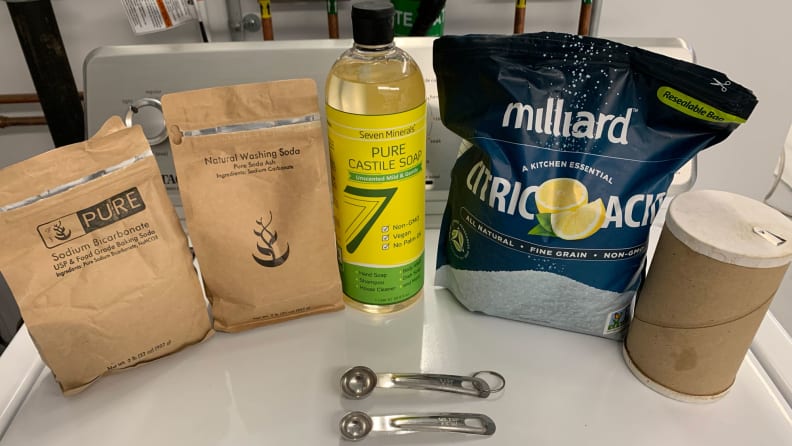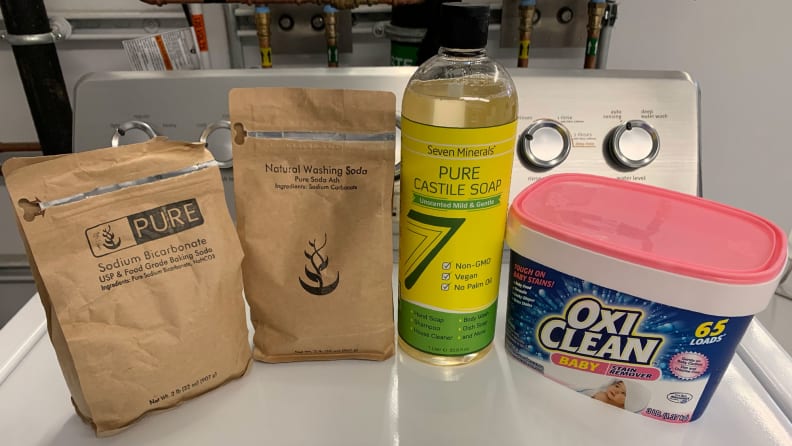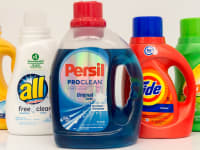Do popular DIY natural cleaning products actually work?
We tested DIY detergents to find which ones worked best.
 Credit:
Getty Images / artursfoto
Credit:
Getty Images / artursfoto
Recommendations are independently chosen by Reviewed's editors. Purchases made through the links below may earn us and our publishing partners a commission. Prices were accurate at the time this article was published but may change over time.
If you're like me, you might have dabbled in the world of DIY cleaning products. Traditional cleaning products might be highly effective against tough stains, but they're not always great for you or for the environment-and for most routine cleaning you don't need to use the nuclear option. For me, researching greener cleaning solutions led to the realization that most of them used the same common ingredients. "That doesn't seem that hard to make," quickly led to, "I could make that," and before long I was staring at a load of not-quite-clean laundry, wishing I'd ordered fewer soap nuts.
The problem is, there are a lot of different DIY natural cleaning product recipes out there, and most of them don't work very well. While most DIY recipes cost significantly less per load compared to a brand-name cleaner (especially the eco-friendly options), it can get expensive to test out different homemade formulations. And as I found out, it's easy to get discouraged after a few duds.
This is where I can help. Using Reviewed's appliance testing lab-including temperature regulators to ensure consistent washes, standardized stains, and measurement tools- I tested a few of the most popular DIY natural cleaning product recipes online to find out how effective they really are.
How I tested DIY laundry detergents
The main test here is stain removal, so I filled up our Maytag MVWC565FW with a standardized load of laundry and a standardized test strip. These strips contain a gamut of AHAM-approved stains (which includes cocoa, sweat, pig's blood, red wine, and oil). By comparing the color of the original stain to the color of the stain post-wash, I determined how well the detergent was able to clean the stain. I also compared the DIY detergent's performance to two controls: a leading eco-friendly laundry detergent and no detergent at all.
The winning DIY laundry detergent

This DIY laundry detergent recipe was able to out-clean Seventh Generation.
Ingredients:
- 3 parts Castile soap
- 4 parts washing soda
- 2 parts baking soda
- 2 parts citric acid
- 1 part coarse sea salt
Instructions: Mix all the dry ingredients together and add 2-3 Tbsp. to the washing machine before you throw in your laundry. (For our tests, I used 3 Tbsp.) If you want to pre-mix the ingredients together in bulk, we'd recommend using a ground-up bar of Castile soap instead of the liquid version. You can use your food processor to do the grinding.
Results: I've seen this recipe posted on a number of sites. As one of the more popular recipes I tested, I wasn't surprised it ended up doing better than the rest. I was a bit surprised, however, that it out-performed our brand-name control detergent, Seventh Generation.

From top to bottom: an unwashed stain strip, one washed without detergent, one washed with Seventh Generation, and one washed with the DIY recipe. From left to right, the swatches are a control, sweat, oil, cocoa, blood, and wine.
While this recipe didn't clean sweat and blood as well as Seventh Generation, it did much better on the oil and cocoa stains. It also outperformed every other DIY laundry detergent I tested by a significant margin.
While this recipe still slightly underperformed Tide, it makes a good, more affordable alternative to the eco-friendly option.
Other DIY laundry detergents tested
A recipe featuring OxiClean

This recipe leverages OxiClean but still wasn't able to out-perform our top DIY detergent recipe.
One popular DIY cleaner sort of cheats a little since it uses a brand-name cleaner, OxiClean Baby in its formulation. OxiClean Baby does get an A rating from the Environmental Working Group, which rates products for the eco-friendliness and overall safety of their ingredients. This recipe performed second best in this initial batch, falling slightly behind Seventh Generation but very far ahead of the next best cleaner.

This DIY recipe managed to out-clean Seventh Generation slightly on the oil swatch (third square from the left), but underperformed everywhere else. This recipe barely performed better than no detergent at all.
A bare-bones method

A simple DIY recipe that only called for washing soda, Castile soap, and salt—it didn't clean very well.
This recipe just doesn't clean well. According to our test results, this recipe cleaned our test strip just slightly better than no detergent at all. It was pretty remarkable how consistently poorly this one seemed to clean, when the best-performing combination only had a few additional ingredients.

This recipe barely performed better than no detergent at all.
How I tested DIY dishwasher detergents

Cascade was able to clean away 40–50% of the spinach.
For testing DIY dishwasher detergents, I relied on the hardest test stain I use for dishwasher testing: ground-up spinach. This stain is meant to simulate a thick sauce that's been allowed to dry on the dish. I measured the stains before and after washing them in our KitchenAid KDFE104HPS dishwasher, to determine how much has been cleaned away. I also wanted to establish a few baselines, so I tested one load without any detergent and one with Cascade, a popular name-brand detergent. The dishwasher was only able to remove about 10%-20% of the stain, while Cascade was able to clean away about half the stain. This gives us a high ceiling to work with, should any DIY detergents manage to out-clean Cascade.
The winning DIY dishwasher detergent

With only four ingredients, this DIY detergent can clean better than Cascade.
Ingredients:
- 2 parts washing soda
- 2 parts baking soda
- 2 parts citric acid
- 1 part non-iodized salt
Instructions: Combine the ingredients thoroughly and add 3 Tbsp. of the mixture to the detergent cup.
Results: This recipe packs some impressive cleaning power. It cleaned about 60% of the spinach stain out, which was much better than Cascade's 45% stain removal-pretty impressive for a four-ingredient DIY detergent.

This DIY recipe managed to out-clean Cascade, erasing over 60% of the spinach stain.
Based on these test results, I'd recommend you try this recipe. As an added bonus, there's a lot of overlap between the ingredients for this recipe and the winning DIY laundry detergent. If you were inclined to try one, it would be pretty easy to try both. The wonderful synergies of DIY detergents!
Other DIY dishwasher detergents tested
The dish soap hack

While this DIY recipe does work if you’re desperate, I’d strongly advise against using dish soap in your dishwasher.
I'd seen this popular DIY trick floating around a bunch of different sites, most noticeably in a HuffPost article. Normally you shouldn't use dish soap in the dishwasher: It'll overflow the machine with a flood of suds. Because of the potential for creating a larger mess than you're trying to clean, I'd recommend against this being your go-to for a daily detergent.

While using a few drops of dish soap might work in the short-term, it's a risky long-term solution.
Baking soda and essential oil

This DIY recipe may only have two ingredients, but it managed to clean as well as a brand-name detergent.
I saw a bunch of variations on "just add some washing soda and essential oil" recipes, with lemon being the most commonly-recommended essential oil. Despite its simplicity, this recipe managed to clean about as well as Cascade. We'd recommend caution when using essential oils, however—the scent sticks around for a few wash cycles.

Washing soda and lemon essential oil were able to erase about half of our test stain.
The verdict
Based on my previous experience with DIY cleaners, my initial expectations were fairly low. I was expecting the best recipe in each category to maybe come close to the eco-friendly detergents but ultimately fall short.
The DIY dishwasher detergents were especially surprising. Most did about as well as Cascade, with the winner surpassing its cleaning capabilities by a sizable margin.
The laundry recipes were more in line with my own experiences with DIY laundry detergents: Most were disappointing (looking at you, unused bag of soap nuts). Still, the winner was able to outperform Seventh Generation, if not Tide.
If you're trying to clean some really tough stains, it probably makes sense to keep some traditional cleaners on hand. For most cleaning, however, these DIY recipes should work more than well enough for cleaning your day-to-day laundry and dishes.
Do you have a favorite DIY cleaner you swear by? Let us know on our Facebook group, Know Your Stuff!





